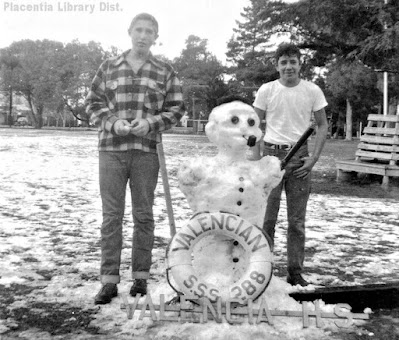 |
| Snow at Valencia High School, Placentia, 1949 (Courtesy Placentia Library District) |
Q: Has Orange County ever had a snowfall that covered the whole county?
A: That last occurred on January 11, 1949. The foothills got about five inches of snow, but most of the county got less. Tustin historian Juanita Louvret writes, "You had to work hard to gather enough snow to make a decent snowman."
Still, Orange County looked like a winter wonderland, and almost everyone with a camera photographed their suddenly transformed neighborhoods.
Prior to 1949, you have to go back to Jan. 12, 1882 to find a record of another significant snowfall here.
Widespread snowfall was reported by some locals March 1, 2023, but those better acquainted with cold weather recognized it as “graupel” -- tiny wads of slush, not snowflakes. The graupel melted almost instantly upon touching the ground.
Q: Was the 1938 Flood the worst in O.C.’s history?
A: In terms of deaths (more than 50) and property damage, 1938 was our worst natural disaster. But for sheer volume of water, January 1862 brought us the ultimate frog-strangler. Historian Jim Sleeper wrote that the peak flow through Santa Ana Canyon in 1862 was “320,000 cubic feet per second, compared with 100,000 in 1938...” The Western half of Orange County became an extension of the ocean for a while. Luckily, there was hardly anyone around in 1862 to complain about it.
Q: With no groundhogs in Orange County, what signs of nature predict our local weather?
A: Local Indians once believed that gophers relocating their burrows to higher ground was a sign of an approaching rainy season. According to historian Jim Sleeper, the early pioneers had innumerable "sure signs" -- from heavy acorn growth, to whales hugging the coast, to maple leaves all turning color at once. These methods were all as dependable as ol' Punxsutawney Phil.

No comments:
Post a Comment